Design and Analysis of a Dual Airgap Radial Flux Permanent Magnet Vernier Machine with Yokeless Rotor
Abstract
:1. Introduction
2. Machine Topology, Specifications, and Working Principle
3. Performance Evaluation and Comparison of Existing and Proposed Machine
3.1. Mesh Settings
3.2. Reluctance and Inductances
3.3. Flux Density, Flux Linkage, and Back EMF
3.4. Cogging Torque and Torque Ripple
3.5. Electromagnetic Torque and Torque Density
3.6. Core Loss and Efficiency
4. Comparison between PMSM and PMVM
5. Experimental Validation
5.1. Experimental Setup
5.2. Experimental Results and Discussion
6. Conclusions
Author Contributions
Funding
Institutional Review Board Statement
Informed Consent Statement
Data Availability Statement
Conflicts of Interest
References
- Patterson, D.; Spee, R. The design and development of an axial flux permanent magnet brushless DC motor for wheel drive in a solar powered vehicle. IEEE Trans. Ind. Appl. 1995, 31, 1054–1061. [Google Scholar] [CrossRef]
- Niu, S.; Ho, S.L.; Fu, W.N.; Wang, L.L. Quantitative Comparison of Novel Vernier Permanent Magnet Machines. IEEE Trans. Magn. 2010, 46, 2032–2035. [Google Scholar] [CrossRef]
- Ishizaki, A.; Tanaka, T.; Takahashi, K.; Nishikata, S. Theory and Optimum Design of PM Vernier Motor. In Proceedings of the 1995 Seventh International Conference on Electrical Machines and Drives, Durham, UK, 11–13 September 1995; pp. 208–212. [Google Scholar]
- Gerber, S.; Wang, R.-J. Design and evaluation of a PM vernier machine. In Proceedings of the 2015 IEEE Energy Conversion Congress and Exposition (ECCE), Montreal, QC, Canada, 20–24 September 2015; pp. 5188–5194. [Google Scholar]
- Shentu, L.; Ma, Y.; Wang, J.; Zhou, J.; Zhou, L.; Qian, K. Design and Analysis of a Direct-Drive Permanent Magnet Vernier Motor for Electric Drilling Applications. In Proceedings of the 2018 21st International Conference on Electrical Machines and Systems (ICEMS), Jeju, Korea, 7–10 October 2018; pp. 81–86. [Google Scholar]
- Liu, Y.; Zhu, Z. Magnetic gearing effect in vernier permanent magnet synchronous machines. In Proceedings of the 2017 IEEE Energy Conversion Congress and Exposition (ECCE), Cincinnati, OH, USA, 1–5 October 2017; pp. 5025–5032. [Google Scholar]
- Kim, B.; Lipo, T.A. Operation and Design Principles of a PM Vernier Motor. IEEE Trans. Ind. Appl. 2014, 50, 3656–3663. [Google Scholar] [CrossRef]
- Zou, T.; Li, D.; Qu, R.; Jiang, D.; Li, J. Advanced High Torque Density PM Vernier Machine with Multiple Working Harmonics. IEEE Trans. Ind. Appl. 2017, 53, 5295–5304. [Google Scholar] [CrossRef]
- Li, J.; Chau, K.T.; Jiang, J.Z.; Liu, C.; Li, W. A New Efficient Permanent-Magnet Vernier Machine for Wind Power Generation. IEEE Trans. Magn. 2010, 46, 1475–1478. [Google Scholar] [CrossRef]
- Tlali, P.M.; Wang, R.-J.; Gerber, S. Comparison of PM Vernier and Conventional Synchronous 15 kW Wind Generators. In Proceedings of the 2018 XIII International Conference on Electrical Machines (ICEM), Alexandroupoli, Greece, 3–6 September 2018; pp. 2065–2071. [Google Scholar]
- Zhao, F.; Lipo, T.A.; Kwon, B.I. Magnet flux focusing design of double stator permanent magnet Vernier machine. In Proceedings of the Conference on the Computation of Electromagnetic Fields (Compumag 2013), Budapest, Hungary, 30 June–4 July 2013; pp. 1–4. [Google Scholar]
- Kim, B.; Lipo, T.A. Analysis of a PM Vernier Motor with Spoke Structure. In Proceedings of the IEEE Energy Conversion Congress and Exposition, Pittsburgh, PA, USA, 14–18 September 2014; pp. 5034–5041. [Google Scholar]
- Zhao, F.; Lipo, T.A.; Kwon, B.-I. A Novel Dual-Stator Axial-Flux Spoke-Type Permanent Magnet Vernier Machine for Direct-Drive Applications. IEEE Trans. Magn. 2014, 50, 1–4. [Google Scholar] [CrossRef]
- Du, Z.S.; Lipo, T.A. High torque density ferrite permanent magnet vernier motor analysis and design with demagnetization consideration. In Proceedings of the 2015 IEEE Energy Conversion Congress and Exposition (ECCE), Montreal, QC, Canada, 20–24 September 2015; pp. 6082–6089. [Google Scholar]
- Du, Z.S.; Lipo, T.A. Torque Performance Comparison Between a Ferrite Magnet Vernier Motor and an Industrial Interior Permanent Magnet Machine. IEEE Trans. Ind. Appl. 2017, 53, 2088–2097. [Google Scholar] [CrossRef]
- Li, D.; Qu, R.; Li, J.; Xu, W. Consequent-Pole Toroidal-Winding Outer-Rotor Vernier Permanent-Magnet Machines. IEEE Trans. Ind. Appl. 2015, 51, 4470–4481. [Google Scholar] [CrossRef]
- Xie, K.; Li, D.; Qu, R.; Gao, Y. A Novel Permanent Magnet Vernier Machine with Halbach Array Magnets in Stator Slot Opening. IEEE Trans. Magn. 2017, 53, 1–5. [Google Scholar] [CrossRef]
- Wei, L.; Nakamura, T. A Novel Dual-Stator Hybrid Excited Permanent Magnet Vernier Machine with Halbach-Array PMs. IEEE Trans. Magn. 2021, 57, 1–5. [Google Scholar] [CrossRef]
- Baloch, N.; Kwon, B.; Gao, Y. Low Cost High Torque Density Dual-Stator Permanent Magnet Vernier Machine. In Proceedings of the 2018 IEEE International Magnetics Conference (INTERMAG), Singapore, 23–27 April 2018; p. 1. [Google Scholar]
- Gao, Y.; Qu, R.; Li, D.; Fang, H.; Li, J.; Kong, W. A Novel Dual-Stator Vernier Permanent Magnet Machine. IEEE Trans. Magn. 2017, 53, 1–5. [Google Scholar] [CrossRef]
- Chai, F.; Cui, S.; Cheng, S. Performance analysis of double-stator starter generator for the hybrid electric vehicle. IEEE Trans. Magn. 2005, 41, 484–487. [Google Scholar] [CrossRef]
- Huang, X.; Zhang, K.; Wu, L.; Fang, Y.; Lu, Q. Design of a Dual-Stator Superconducting Permanent Magnet Wind Power Generator with Different Rotor Configuration. IEEE Trans. Magn. 2017, 53, 1. [Google Scholar] [CrossRef]
- Raminosoa, T.; Gerada, C.; Othman, N.; Lillo, L. Rotor losses in fault-tolerant permanent magnet synchronous machines. IET Electr. Power Appl. 2011, 5, 75. [Google Scholar] [CrossRef] [Green Version]
- Yazdan, T.; Atiq, S.; Kwon, B.-I.; Baloch, N.; Kwon, J.-W. Two Phase Dual-Stator Axial-Flux PM BLDC Motor With Ironless Rotor Using Only-Pull Drive Technique. IEEE Access 2019, 7, 82144–82153. [Google Scholar] [CrossRef]
- Dumas, F.; Matt, D.; Jac, J.; Enrici, P. A design approach for an axial-flux permanent magnet motor. In Proceedings of the XIX International Conference on Electrical Machines—ICEM 2010, Rome, Italy, 6–8 September 2010; pp. 1–6. [Google Scholar]

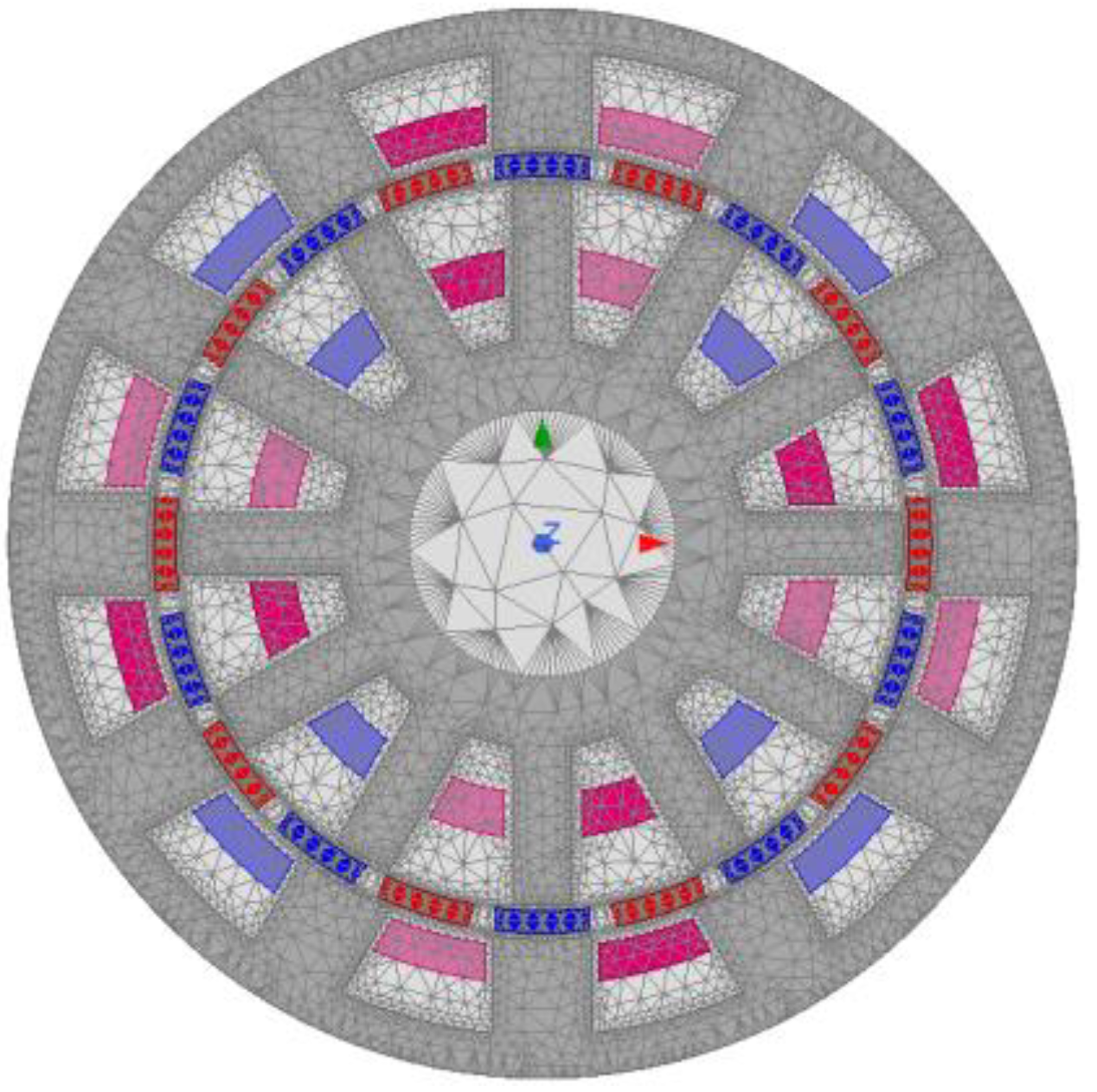


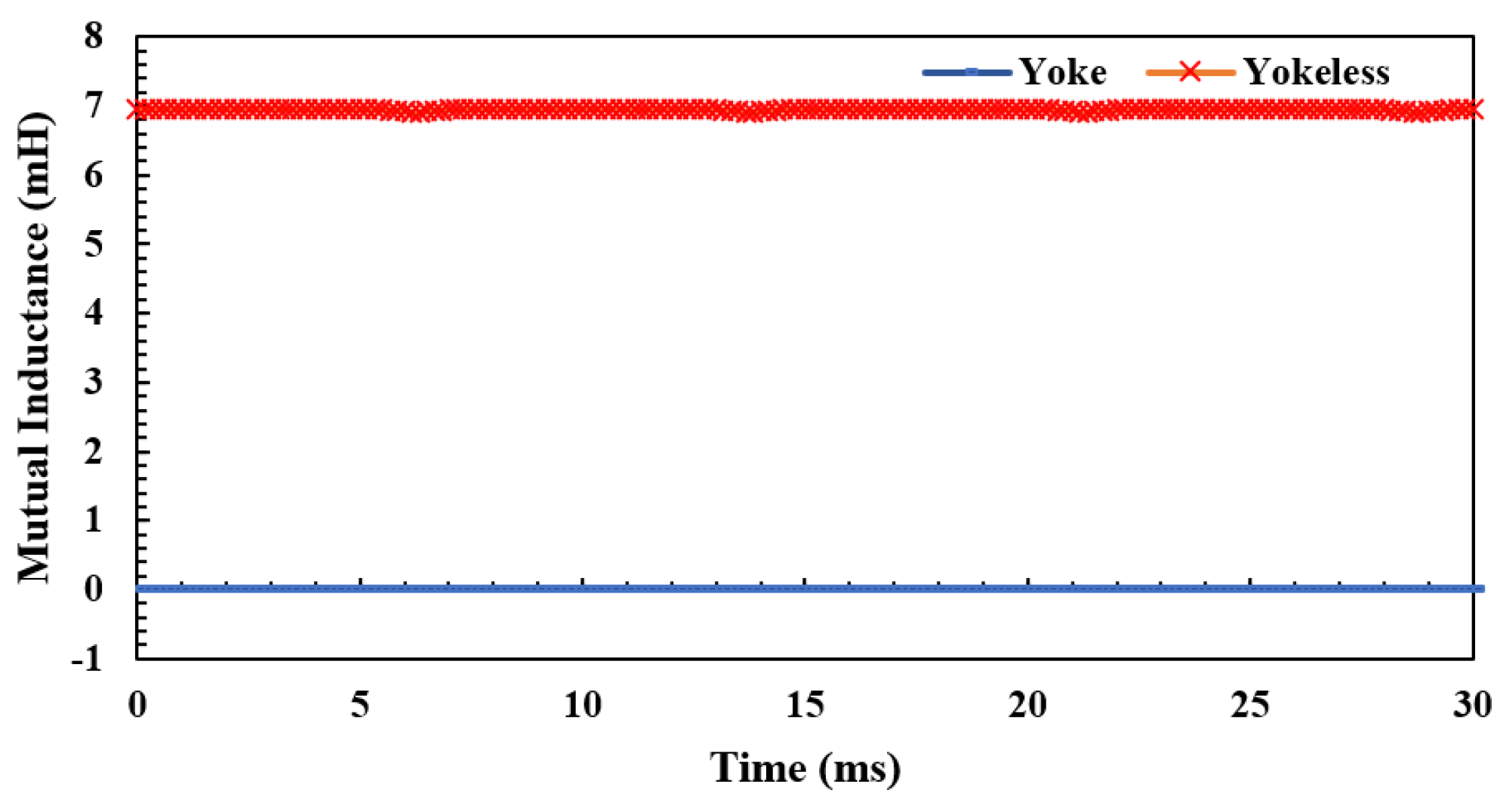
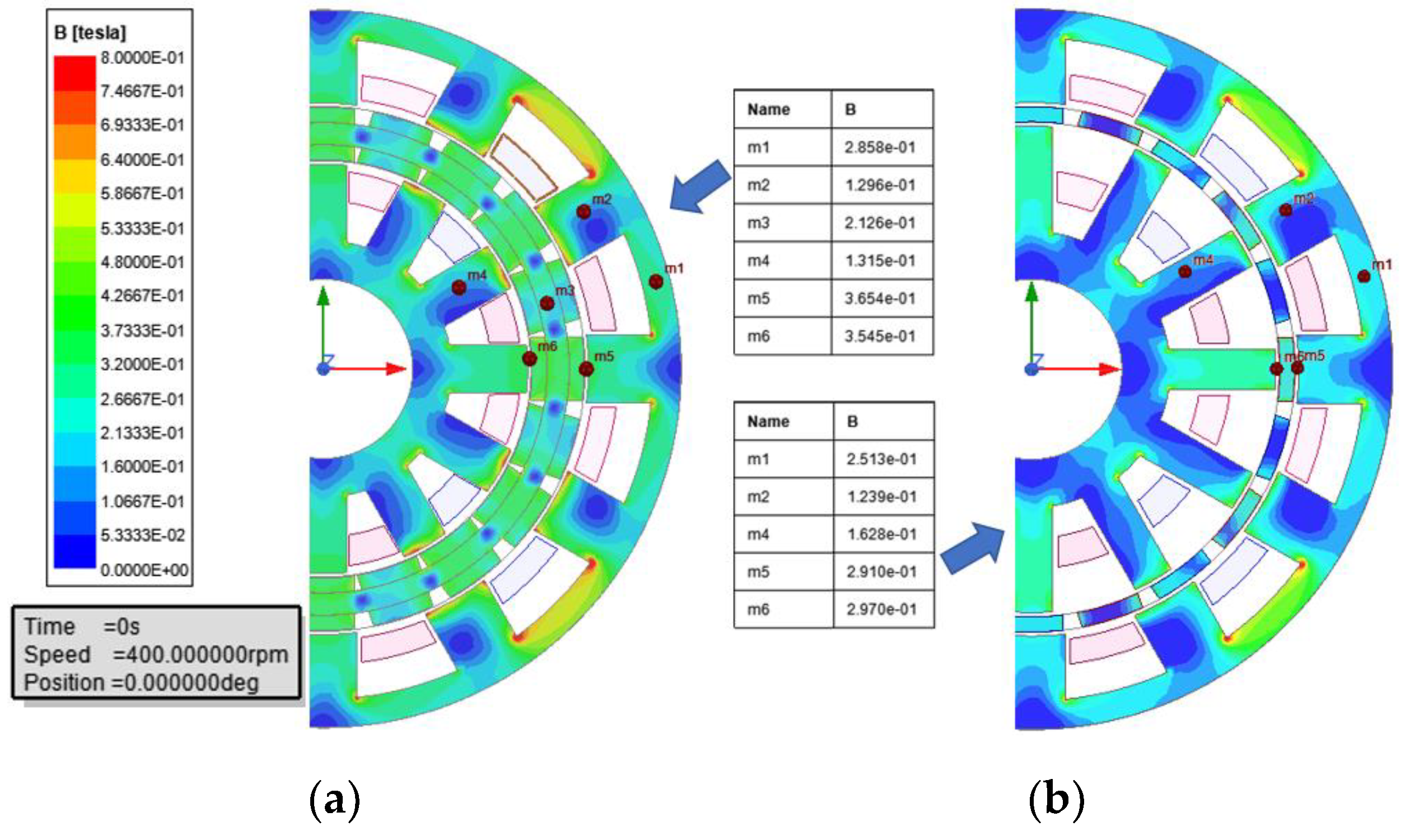
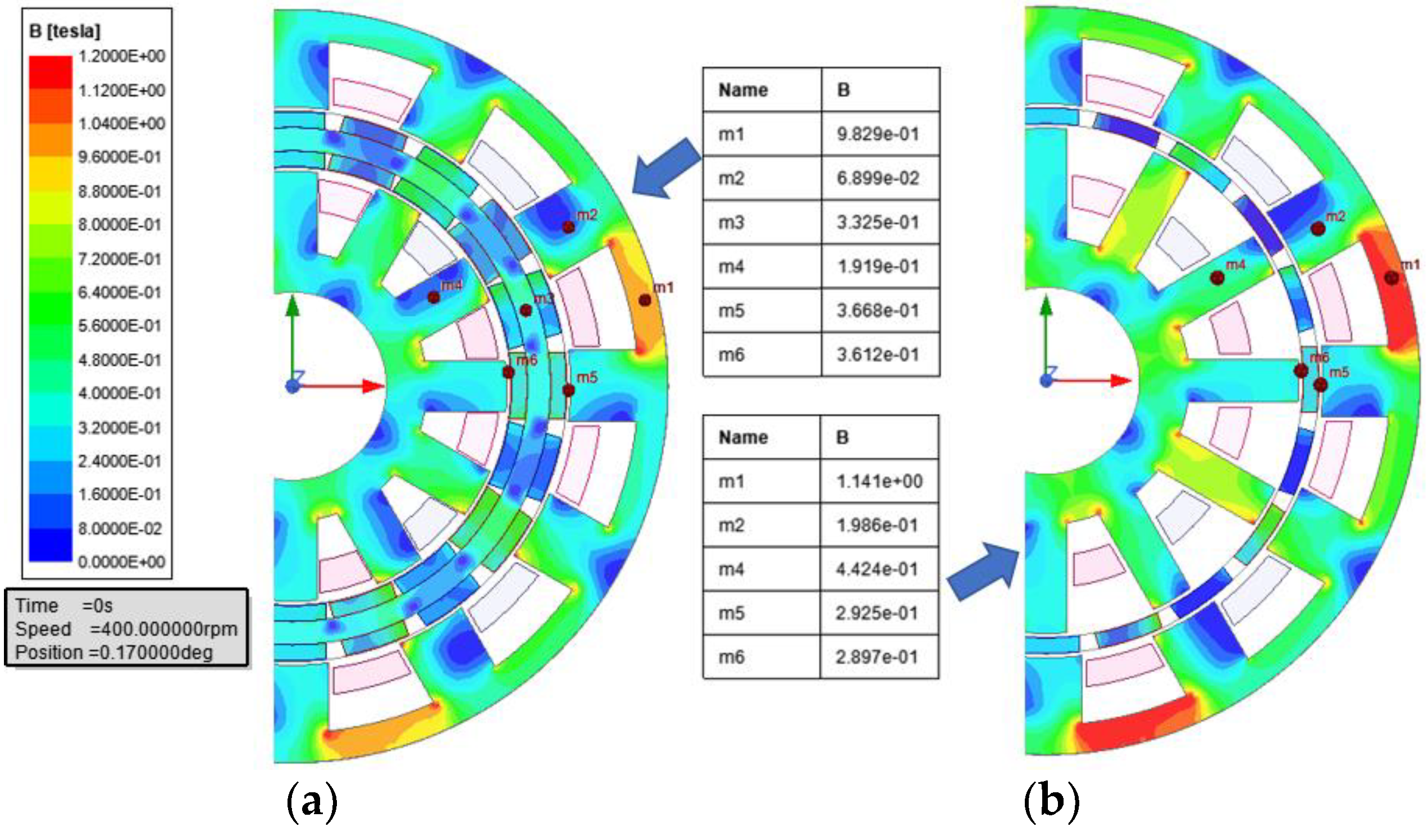




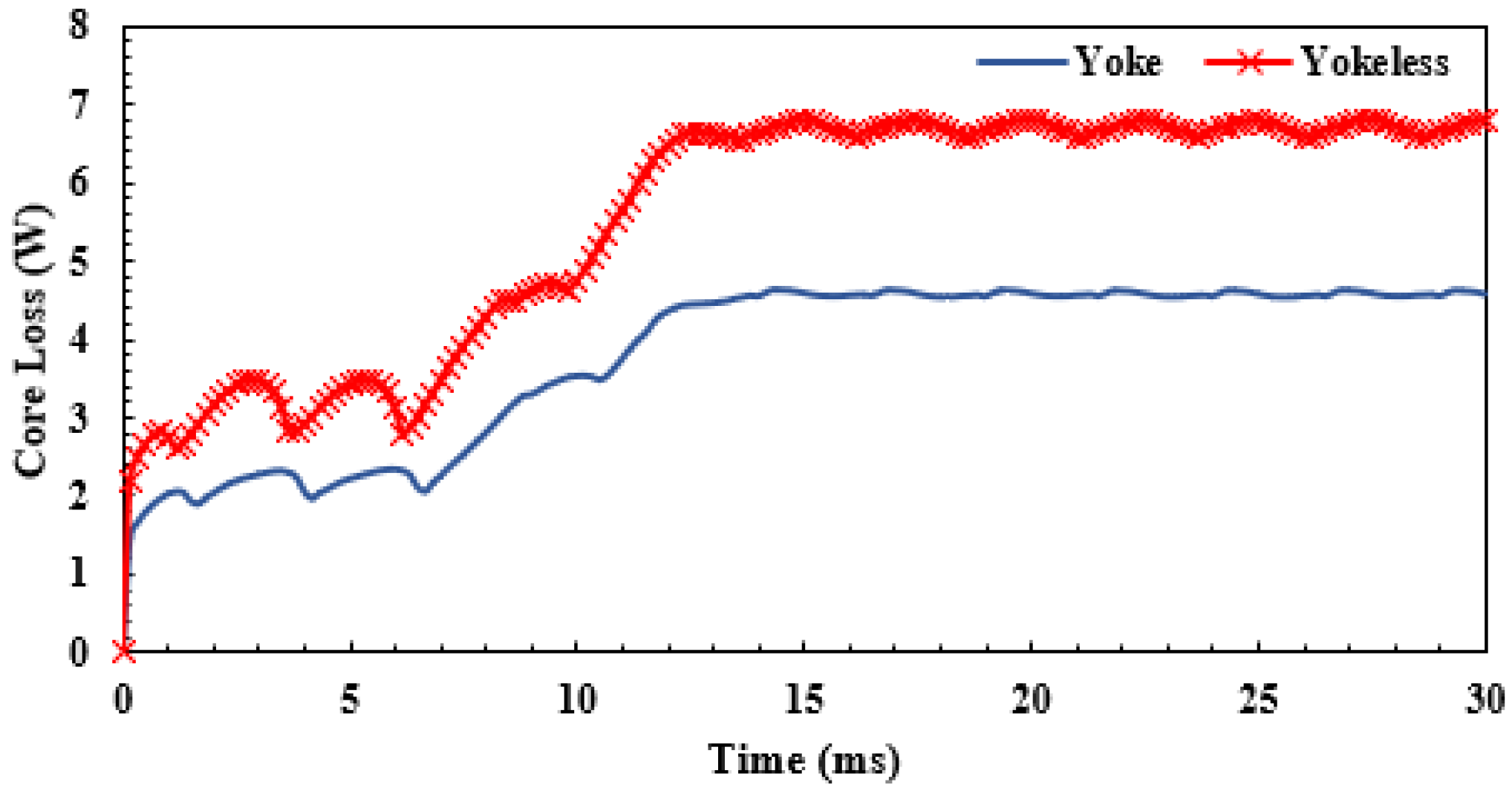
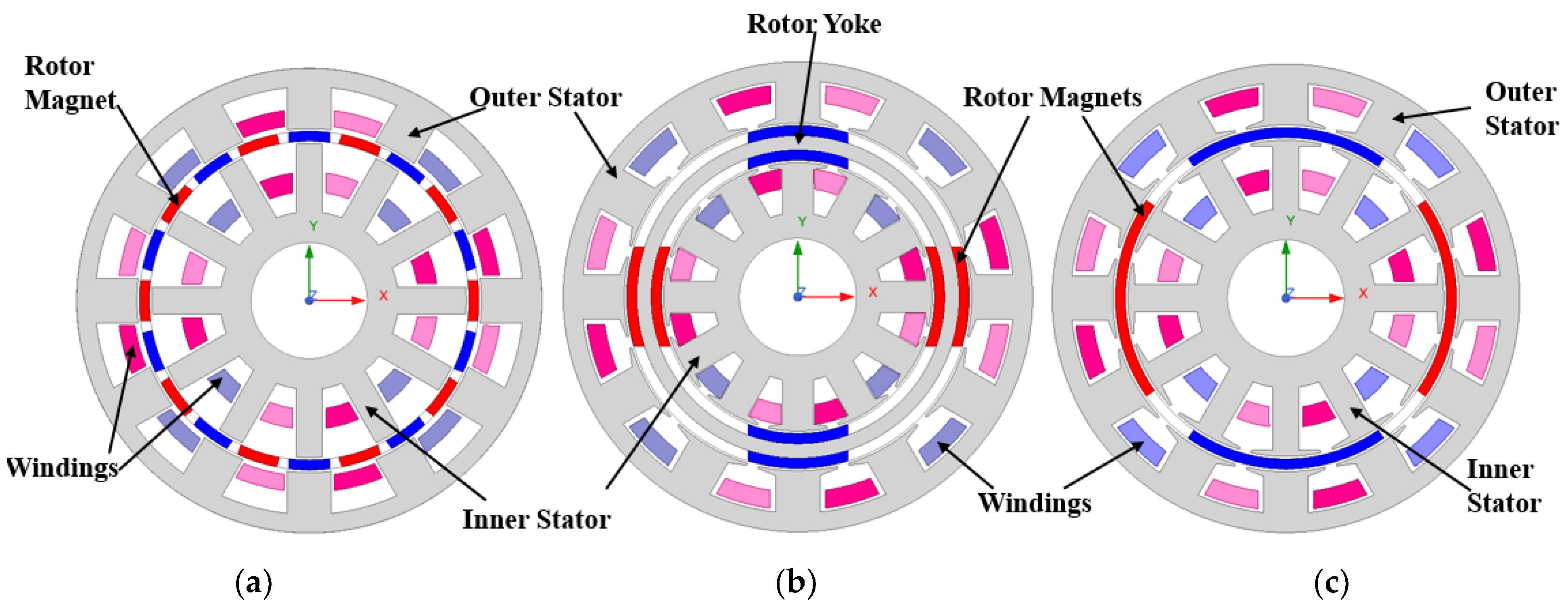





| Parameter | Units | Values | |
|---|---|---|---|
| With Iron Yoke Rotor | Yokeless Rotor | ||
| Active outer diameter | mm | 120 | |
| Active inner diameter | mm | 30 | |
| Outer diameter of the inner stator | mm | 68.6 | 81.1 |
| Active axial length | mm | 100 | |
| Number of rotor pole pairs | - | 10 | |
| Number of stator slots | - | 12 | |
| Number of stator poles | - | 4 | |
| Length of air gap | mm | 0.7 | |
| Magnet type | - | NdFeb bonded (Br = 0.5 T, Hc = −304 kA/m) | |
| Rotor core material | - | Steel S50PN470 | Non-Mag. SUS304 |
| Volume of magnet | L | 0.105 | 0.053 |
| Machine volume | L | 1.06 | |
| Number of turns per slot | - | 70 | |
| Slot fill factor (outer/inner stator) | % | 50/60 | 50/50 |
| Rated rotational speed | rpm | 400 | |
| Max. phase current | Arms | 4.7 | |
| Parameter | Units | Values | |
|---|---|---|---|
| With Iron Yoke Rotor | Yokeless Rotor | ||
| Back EMF (inner/outer) | V | 22.21/17.38 | 19.45/17.52 |
| Cogging torque pk2pk | Nm | 0.773 | 0.089 |
| Max. phase current | Arms | 4.7 | |
| Torque ripple | % | 5.9 | 2.5 |
| Mutual inductance | mH | 0.027 | 6.95 |
| Average torque | Nm | 13.43 | 12.57 |
| Machine volume | L | 1.06 | |
| Magnet volume | L | 0.105 | 0.053 |
| Torque density | Nm/L | 12.67 | 11.86 |
| Torque per magnet volume | Nm/L | 127.6 | 238.9 |
| Copper loss | W | 57.3 | |
| Core loss | W | 3.27 | 5.53 |
| Total loss | W | 60.6 | 62.9 |
| Efficiency | % | 90.3 | 89.2 |
| Parameter | Units | Values | |||
|---|---|---|---|---|---|
| PMVM (Yokeless) | PMSM (Yokeless) | PMSM (Yoke) | PMSM (Yokeless) | ||
| Magnet type | - | NdFeb Bonded | NdFeb Sintered | ||
| Back EMF | - | 36.9 | 15.21 | 43.24 | 38.7 |
| Average torque | Nm | 12.57 | 5.0 | 10.47 | 11.9 |
| Torque ripple | % | 2.5 | 78 | 45 | 118 |
| Magnet volume | Nm/L | 0.05 | |||
| Torque per magnet volume | Nm/L | 238.9 | 96.2 | 201.3 | 228.8 |
Publisher’s Note: MDPI stays neutral with regard to jurisdictional claims in published maps and institutional affiliations. |
© 2021 by the authors. Licensee MDPI, Basel, Switzerland. This article is an open access article distributed under the terms and conditions of the Creative Commons Attribution (CC BY) license (https://creativecommons.org/licenses/by/4.0/).
Share and Cite
Siddiqi, M.R.; Yazdan, T.; Im, J.-H.; Humza, M.; Hur, J. Design and Analysis of a Dual Airgap Radial Flux Permanent Magnet Vernier Machine with Yokeless Rotor. Energies 2021, 14, 2311. https://doi.org/10.3390/en14082311
Siddiqi MR, Yazdan T, Im J-H, Humza M, Hur J. Design and Analysis of a Dual Airgap Radial Flux Permanent Magnet Vernier Machine with Yokeless Rotor. Energies. 2021; 14(8):2311. https://doi.org/10.3390/en14082311
Chicago/Turabian StyleSiddiqi, Mudassir Raza, Tanveer Yazdan, Jun-Hyuk Im, Muhammad Humza, and Jin Hur. 2021. "Design and Analysis of a Dual Airgap Radial Flux Permanent Magnet Vernier Machine with Yokeless Rotor" Energies 14, no. 8: 2311. https://doi.org/10.3390/en14082311







